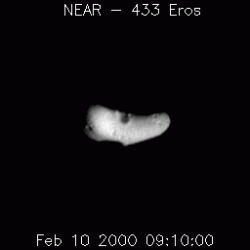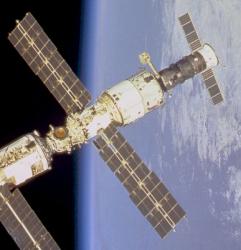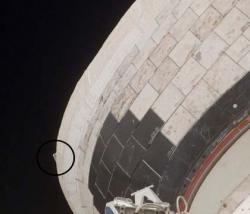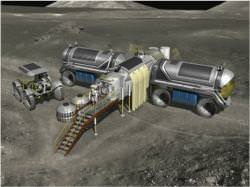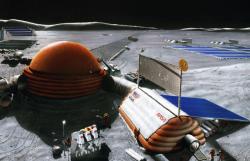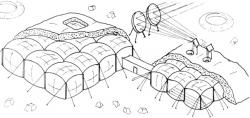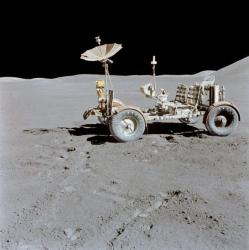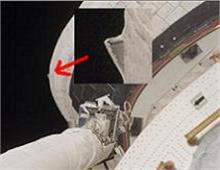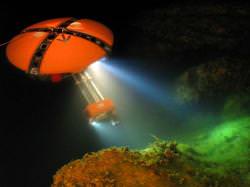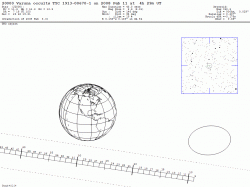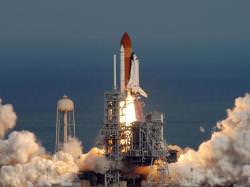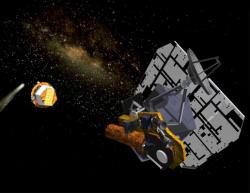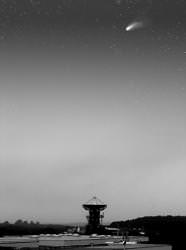It’s a day meant for celebrating love, and what better way to mark the occasion than to take a look at asteroid Eros! While its mythical name is fitting of the holiday, exploring the famous asteroid went into history on February 14, 2000 when the NEAR spacecraft was successfully inserted into orbit around 433 Eros, becoming the first artificial satellite of an asteroid – an asteroid you can visit with just a telescope!
The Near Earth Asteroid Rendezvous mission had begun its journey on February 17, 1996 as the first of NASA’s Discovery missions to rendezvous with asteroid 433 Eros. During the journey to Eros, NEAR flew within 1212 kilometers of asteroid Mathilde on June 27, 1997 and was to continue onto Eros and obtain orbit in December of 1998. But, as luck would have it, a computer malfunction stopped the rendezvous burn of NEAR’s bipropellant engine and it flew past the asteroid on December 23, 1998. Mission operators quickly reprogrammed the spacecraft to obtain scientific flyby information and set up an orbit that would carry NEAR back to Eros in February 2000.
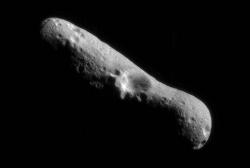 On the first Valentine’s Day of the new millennium, NEAR went into operation again about an hour after reaching its orbital destination and sent its own Valentine card back towards Earth – the first images of an asteroid taken from an orbiting spacecraft. Features as small as a 330 meters came to life and notably a prominent, sharp-rimmed crater which may have been caused by an impact. Inside the crater walls are subtle variations in brightness that hint at some layering of the rock in which the crater formed. Narrow grooves that run parallel to the long axis of Eros cut through the southeastern part of the crater rim. A house-sized boulder is present near the floor of the crater which appears to have rolled down the bowl-shaped crater wall. A large number of boulders are also seen in other areas of the old asteroid’s heavily cratered surface.
On the first Valentine’s Day of the new millennium, NEAR went into operation again about an hour after reaching its orbital destination and sent its own Valentine card back towards Earth – the first images of an asteroid taken from an orbiting spacecraft. Features as small as a 330 meters came to life and notably a prominent, sharp-rimmed crater which may have been caused by an impact. Inside the crater walls are subtle variations in brightness that hint at some layering of the rock in which the crater formed. Narrow grooves that run parallel to the long axis of Eros cut through the southeastern part of the crater rim. A house-sized boulder is present near the floor of the crater which appears to have rolled down the bowl-shaped crater wall. A large number of boulders are also seen in other areas of the old asteroid’s heavily cratered surface.
After a year orbiting Eros, NEAR was about out of fuel. Only designed to orbit the asteroid, the spacecraft wasn’t equipped to land and the plan was to simply let it eventually crash onto the surface. Having met all of its research objectives, scientists had a developed fondness for NEAR project and decided to try to land – a procedure which would allow them to test complex maneuvers and get close-up pictures of the surface. These pictures would allow scientists to see objects as small as 10 cm in diameter. The command was given and NEAR slowed its circular orbit and executed a series of braking turns as it approached the surface. The landing site was in the saddle-shaped middle of the asteroid where temperatures vary from 100 C during the day to -150 C) at night – a day that last less than five and half hours! Although the weak gravity only provided an escape velocity of a mere 22 mph, it held the survival ticket of the automobile-sized NEAR on February 12, 2001. Then the probe made space history by successfully landing atop the space rock, more than 316 million kilometers from Earth.
 Why not celebrate this Valentine’s Day Anniversary by taking a look at Eros yourself? The 33 kilometer long, 13 kilometer diameter rock is the second largest near-Earth asteroid and is easily seen in larger backyard telescopes. Holding an average magnitude 11.5, you’ll find Eros hanging out in the circlet of Pisces just after sunset. For those with GoTo telescope systems or setting circles, finding Eros is as easy as entering RA 23h 20m 11s Dec 3°2’13”! Enjoy your journey to Eros tonight… and wish NEAR a happy anniversary!
Why not celebrate this Valentine’s Day Anniversary by taking a look at Eros yourself? The 33 kilometer long, 13 kilometer diameter rock is the second largest near-Earth asteroid and is easily seen in larger backyard telescopes. Holding an average magnitude 11.5, you’ll find Eros hanging out in the circlet of Pisces just after sunset. For those with GoTo telescope systems or setting circles, finding Eros is as easy as entering RA 23h 20m 11s Dec 3°2’13”! Enjoy your journey to Eros tonight… and wish NEAR a happy anniversary!

